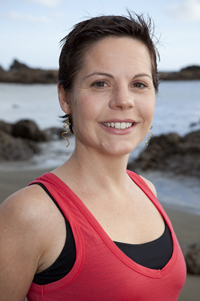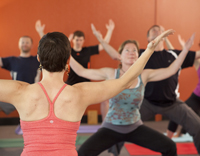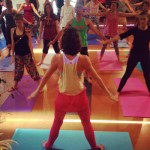by Kelly Fisher, Urban Yoga
After almost a decade of teaching yoga as my full time career, I have had the privilege of watching some of the students who have come to my classes eventually become teachers themselves.
I have had the honour of fielding their questions and helping them through those uncertain first months and years of teaching.
Plus, as a huge geek when it comes to neuropsychology, yoga anatomy, yoga physiology and yoga alignment, I often help new teachers from other lineages get a better handle on how to incorporate those things into their classes.
When new teachers come to me asking advice, these are the top five things I end up sharing with them:
1. Be yourself when you teach yoga
For me, teaching yoga is a creative offering. When you’re doing it well, there is a beautiful alchemy that takes place incorporating who you are as a person, what you have learned in the world, what you’ve learned in the context of yoga as well as how you’re relating to the people in the room.
In that way, yoga classes are like wine. Yoga like wine? Yup.
Just because you’ve tried a 2002 Cabernet Sauvignon from Victoria, Australia does not mean you’ll have any idea what a 2012 Sauvignon Blanc from Marlborough, New Zealand will be like. Similarly, there are a wide variety of yoga styles on offer these days in the Western world and they can vary wildly from each other.
And just like you may know the taste of a 2008 Pinot Noir from Central Otago does not mean that a 2012 Pinot Noir from California will bear much resemblance at all. The year, the climate, the soil, the winemaker will all influence how a wine turns out.
In the same way, just because two teachers are trained up in the same style of yoga does not necessarily mean their classes will be similar.
As teachers, we each bring our personalities and all of our experiences into the room with us each time we teach.
This is a good thing!
The more authentic you can be, the easier it is to get on with actually teaching and the more rapport you can build with your students. The more rapport you have, the more easily your classes will build and the snowball effect of that is that you’ll feel even more comfortable to be authentically you when you’re teaching. The world needs more of us to be ourselves, particularly when we step into the role of teacher.
2. Learn from other teachers and styles
Even once you’ve finished your yoga teacher training, get lots of exposure to all different styles of yoga and many different teachers. Every single yoga experience has something valuable to offer someone studying the art of teaching, regardless of the particular lineage or person doing the teaching.
The more tools you have in your toolkit, the better.
I’ve got my particular way of teaching which I use 90% of the time. However, the other 10% of the time, I’ve got to dig around in my toolkit for a little used tool in order to be able to best communicate with the student in front of me. Every person is wired slightly differently and in order to best teach them, you’ve got to be able to meet them where they are, as they are. It’s the only way you have a hope of being of any service at all.
3. Study how other teachers teach
Attend classes with a variety of other teachers in your town, even if you’ve gone lots of times before. This time you’re not going along to have your own practice or to find your bliss, you’re going in order to study the way that particular teacher embodies and communicates the art of teaching yoga.
You can use these experiences as mirror reflections to see the similarities and the differences between the teacher in the room and yourself. These reflections can serve to highlight what you appreciate so you can figure out how to maximise your expression of it in your teaching. They can also help you observe what you’d like to avoid when you’re the one at the front of the room.
Pay attention to their sequencing – plan to write as much of it down as you can remember afterwards. That really helps you stay present to the art of the teaching going on and it will also allow you some time to consider why they may have structured the class they way that they did. And if you’re not sure, ask!
There is always more to learn. And boy, is it fun!
4. Talk to more experienced teachers and if possible, find a mentor
Often, if you have a pre-existing rapport with a teacher and he or she knows you’re getting started with teaching, you can ask them to talk about their journey and help you with yours. Some of us love to chat about our teaching and are more than willing to facilitate the process for others.
Just be aware though, there are teachers that may not be so keen to share.
Some folks prefer to keep their creative process a little more private. Even for those of us who love to share, it can make us feel quite vulnerable to offer a behind-the-scenes kind of intimacy with someone who hasn’t walked our path or who isn’t yet teaching.
Approach any discussion respectfully and notice if you have permission to dig deeper or if it would be best to just glean what you can on your own just by studying them from a distance.
5. Teaching yoga is about teaching people.
Ultimately, good teaching is about teaching the people in the room. The ingenuity of your sequence, the depth of your knowledge, the pithiness of your jokes, the acrobatic prowess of your demonstrations, the magic of your playlist are all insignificant if you do not connect with the people in the room and help them to connect with themselves.
Students should leave a class with a deeper inward connection and ideally, feeling better about themselves than when they came in. Of course, sometimes yoga can stir up unpleasant emotions and trigger deep insecurities but that shouldn’t be because the teacher was having a bad day or was too busy trying to impress someone to take the time to really see the students.
For many new teachers, having a solid plan prepared in advance is a good way to feel confident about teaching.
It’s great to have a plan but to borrow a phrase from internationally acclaimed expert teacher Noah Maze, the plan (or the theme) ought to be “leverage, not luggage”.
Sometimes, no matter how perfect your plan is, there will be a student for whom you must modify certain poses or even change the plan altogether. I’ve found that if I’m not willing to adapt on the fly to meet the needs of the people in front of me, I end up struggling with my plan as much as the students are struggling with the postures. No one ends up having a very good time at all.
So while it may look like you’re teaching yoga, remember that you’re actually teaching people. It’s a subtle distinction but a significant one.
The world of teaching yoga is a grand adventure. It brings you face to face with yourself every single class and it gives you the opportunity to step out of the way to let something bigger come through you. Some days are better than others and there is always more to learn. It helps to have friends and colleagues along the way.
I’d love to talk teaching yoga with you. I have made a great many mistakes and I have learned lots of things they don’t tell you in your intro yoga teacher training.
If you have any questions or comments about this article, please contact Kelly direct by sending her an email.
About Kelly
 Kelly Fisher, e-RYT 500, has made yoga her full-time career since 2005 having spent most of the previous decade in big business IT and part of the decade before that studying Neuropsychology.
Kelly Fisher, e-RYT 500, has made yoga her full-time career since 2005 having spent most of the previous decade in big business IT and part of the decade before that studying Neuropsychology.
She is the owner of Urban Yoga, the co-founder of Yoga Unlimited,Wellington’s first upmarket yoga and wellness retreat and the catalyst behind Wellington’s offering of the first couple of years of the Global Mala event.
Over the course of her yoga career, Kelly has studied with many teachers from various lineages including Iyengar, Astanga, Satyananda, Prana Flow and Anusara and has investigated related sciences Ayurveda, Acupuncture and Craniosacral therapy. She is grateful for the support and advice she has had on her journey.


Leave a Reply